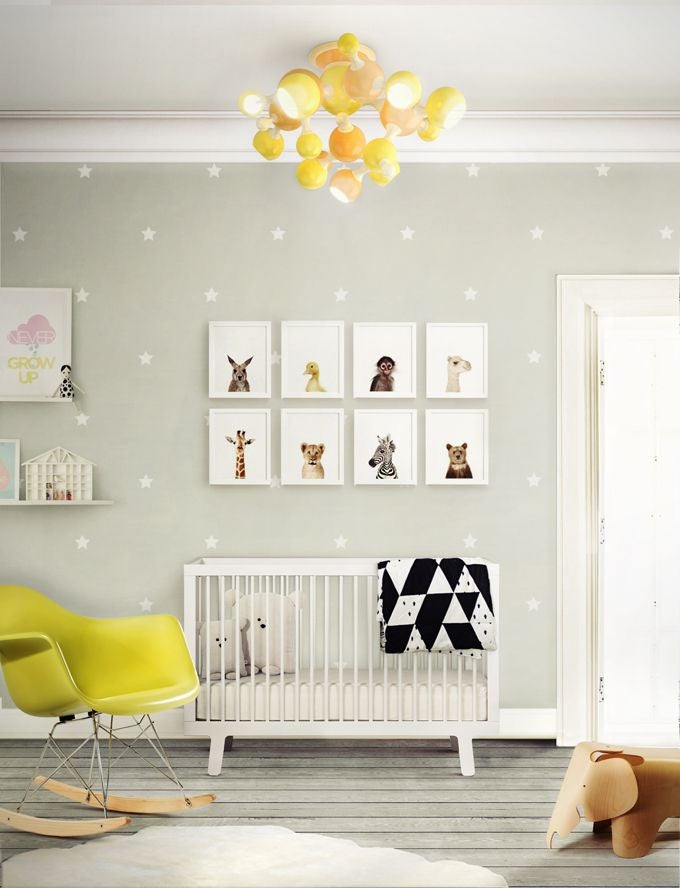We may earn revenue from the products available on this page and participate in affiliate programs.
Buying a crib is a BIG deal. This is where your new baby will spend a lot of his or her time (hopefully sleeping, quietly!). There are so many do’s and don’ts, safety regulations, price ranges, and (of course) style concerns. So we consulted the go-to baby experts, BabyCenter, and spoke with Janet Ozzard, BabyCenter Executive Editor, to create a guide to buying your perfect (and very safe) crib.
slat sizes are important
The slats on your prospective crib should be no more than 2 ⅜” apart (think the width of a soda can!). This is to prevent your tiny baby’s head from getting stuck.
look for adjustable mattress height
As your baby begins to sit up, you’ll want to be able to lower the height of the mattress so your growing bundle of joy doesn’t fall out! Same goes for when your child becomes more active and starts standing—this is an important feature.
beware of decorations
Decorative hardware and cutouts are beautiful, but can be a choking hazard or opportunity to get stuck for your infant. Stick with classic designs and leave the more detailed design to your color scheme and accessories.
don’t buy drop sides
Though this was a popular crib design until very recently, the drop sides of cribs have been deemed extremely unsafe. The CPSC reports that at least 32 infants died this way between 2000 and 2010, so this feature is definitely a deal breaker.
standard frame size
The standard mattress size is at least 51 ¾” long by 27 ¾” wide. Make sure there is no space between the mattress and the frame of your crib so there is, as Ozzard says, “no room for exploring little fingers to get trapped.”
invest in versatility
If you’re looking for your crib to last you a long time, some models convert into toddler beds. Make sure you like the new look of the converted furniture and know that your child should stop sleeping in their crib after they’re more than three feet tall.
safety first
Cribs passed down from your grandma or purchased at the flea market sound cool, but are most likely unsafe.
Ozzard says, “Babies put everything in their mouths. You don’t know where it’s been, what it’s painted with, how sturdy it is, how well the hardware holds. The CPSC recommends not using any crib more than ten years old, for these reasons. Use that groovy vintage crib somewhere else in your nursery, and stick with a CPSC- approved model for everyday.”
If you plan on borrowing a used crib, make sure to see if it has been recalled first. For frequently updated safety information, visit the American Academy of Pediatrics.
can you reuse?
Reusing a crib that has been passed down by a friend or that you used with a previous child is okay only if it is in pristine condition.
Ozzard says, “If it’s only one or two years old, it depends on the condition of the crib. If the crib and mattress are well-maintained, the frame is still solid, every part is still in good shape and all the screws still hold tight, it may not be a problem.”
But beware—if the crib is missing even one part or is even the tinniest bit wobbly or unstable, do not use it. Saving money now is not worth an accident once your baby gets stronger.
what to spend
You don’t have to spend an arm and a leg on a crib—but you certainly can. Most models will cost you $100 to $500, but if you’re feeling fancy, you can also find beautifully designed models for $800 or $1,000 and higher.
assembly
If the
ikea furnitureyou’ve built in the past has always been rickety, you might want to consider hiring a professional. The stability of your crib is of the utmost importance.
say no to bumpers
Once a stylish addition to your baby’s crib, this decorative padding is now deemed unsafe. If bumpers come with the sheet sets you buy, don’t use them (even though they are cute).
Ozzard says, “While a floor model in a store might be tricked out with cute stuffies, adorable blankets, darling animal mobiles and cushy bumpers, remember that your crib should have absolutely nothing in it except a mattress covered with a tight-fitting sheet, and nothing hanging over it. Bare is best.”
